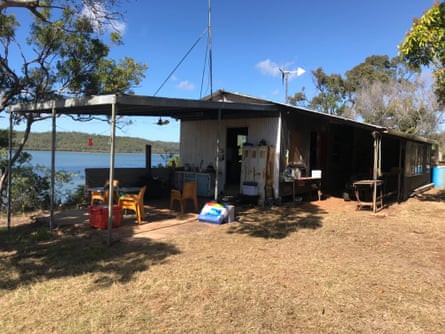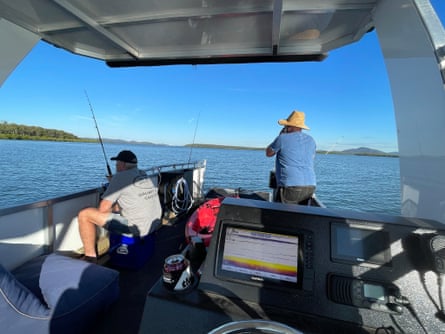“It’s not all palm trees and white sand,” Craig Beckey says, shortly after arriving at his own private island.
As the pandemic hit, the 56-year-old photographer heard about Worthington Island, a 30-minute boat ride from Gladstone in Queensland, through a morning television program. He made an appointment for a tour and in 2021 Beckey bought the island for $385,000.
“I walked around and that afternoon I made an offer,” he says. “I was suddenly like ‘oh shit, I just bought an island’.”
He loves to crack a beer, crank some tunes, and go fishing. But it isn’t exactly glamorous – life on the island involves battling mozzies and midges, and his shed dwelling is effectively glamping, he says.
“I call it a shack, a nine-metre-by-four-metre timber floor, timber frame, off-grid shed with an awning.

“I’ve got solar, I’ve got wind energy, generators, gas cooking. I can run a fridge, I can make my own ice, there’s a pot belly stove.”
And with no jetty, he moors his boat and kayaks in, or parks it in the mangroves.

The shortcomings of owning your own island
The market for private islands took off when Covid-19 struck, and buzz around isolated idylls escalated again last week with the news Poole Island in the Whitsundays was back on the market for less than $1m.
Media coverage talked up the “stunning” tropical getaway – an exclusive island going for less than the average house in Sydney.

The agent, Private Islands Online Australia director Richard Vanhoff, said the location, views and swimming pool were all stunning, but it would take about $100,000 to make Poole Island habitable.
“It will cost you a bit of money moving into Poole. It’s attracted some vagrants, some Robinson Crusoes, who left the windows and doors open. They had a campfire out front, left the windows open and we had cyclonic rain, which just infiltrated the place,” he said.
When he meets a potential owner, he says he’s “frank and honest” about the condition of a property and what is needed, whether they’ll need a helicopter to access it, how they have to pay council rates even though no one collects the bins, and any conditions on the lease.
A buyer might need a chopper to get in, or a plane – which means an airstrip. Some islands won’t have internet access, let alone power or running water.

The Real Estate Institute of Australia warns that it’s buyer beware when it comes to securing your own isle.
“Whilst the idea of buying your own private island sounds exotic, there are shortcomings,” the institute’s president, Hayden Groves, says.
“Buyers need to be careful with environmental requirements for any development or improvements proposed which can limit the use of the island.
“Most island properties are crown land leaseholds too, so buyers have limited time to enjoy their island with no guarantee the lease will be extended or re-offered.”
Multimillion-dollar fixer-uppers
There’s a vast gulf between places like Worthington and Poole Islands and those at the luxury end.
after newsletter promotion
“You’ve got Worthington, the cheapest island I’ve ever sold,” Vanhoff says.
“Then we’ve got islands right through to $30m. For that you’ll get three islands in one, about 5,000 acres [2,000 hectares]. A lot of my islands are off market. That’s the way of the owners. They just have indicated that they don’t want it heralded.
“I just sold one for $38m.”
In Bass Strait, Ninth Island is for sale for $1.98m; you just have to build your own home. Goat Island, on the New South Wales north coast, has its own rainforest and sold for just over a million. Queensland’s Sweers Island is on the market for $3.95m, with the buyer responsible for looking after the local birdlife.
The islands for sale can become holiday houses, homes, or business ventures, depending on local rules.
Vanhoff has had a surge in offers after the publicity about Poole Island – the initial buyer had gone missing, and the place was back on the market.
He says while it needs work, if you added a “large deck and a cabana”, it would have “the most beautiful pool in Australia”.
“It’s fed by a windmill [that] sucks water out of the ocean, and it rolls straight out,” he says, before telling a story about a previous owner’s grandchildren who like to fill the pool with fish.
“One time they caught two sharks … they threw two sharks in and begged their parents to come for a swim,” he says.
“They were only small sharks. But imagine being eaten in your own swimming pool by a shark.”
(That’s the same pool Natascha Mirosch said was full of dead animals when she went on a “ghastly” holiday there in 1977.)

‘It’s island time’
Back on Worthington Island, Beckey says every time he arrives, he wonders why it took him so long. He might not have palm trees and white sand, but he has dolphins, and the occasional dugong.
He’s got bandicoots, echidnas, and special orchids that only grow on the island.
“It’s just so lovely. You can crank up your beatbox as loud as you want. You’ve got no neighbours. Sometimes you just feel like turning up the tunes, sometimes it’s just chilling in the hammock watching the world go by,” he says.
“I think a lot of people would love it. Once you’re there, you’re settled. The fridge is stocked, beer or wine is on ice, everything’s in place. You just kick back, read a book, go fishing. It’s island time. Everything slows down.
“There’s some sort of magic to it.”
https://news.google.com/rss/articles/CBMieGh0dHBzOi8vd3d3LnRoZWd1YXJkaWFuLmNvbS9saWZlYW5kc3R5bGUvMjAyMy9hcHIvMDkvaXRzLW5vdC1hbGwtcGFsbS10cmVlcy13aGF0LWxpZmUtb24tYS1wcml2YXRlLWlzbGFuZC1pcy1yZWFsbHktbGlrZdIBAA?oc=5
2023-04-08 23:04:00Z
CBMieGh0dHBzOi8vd3d3LnRoZWd1YXJkaWFuLmNvbS9saWZlYW5kc3R5bGUvMjAyMy9hcHIvMDkvaXRzLW5vdC1hbGwtcGFsbS10cmVlcy13aGF0LWxpZmUtb24tYS1wcml2YXRlLWlzbGFuZC1pcy1yZWFsbHktbGlrZdIBAA
Bagikan Berita Ini














0 Response to "‘It’s not all palm trees’: what life on a private island is really like - The Guardian"
Post a Comment